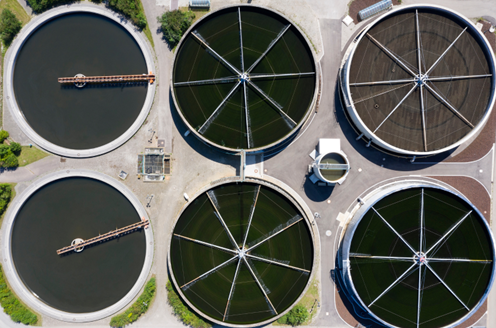Aerobic Treatment ATU Unit and Other Pretreatment Units and Device Types–Process of Suspended Growth–The wastewater is mixed with air in an aeration tank to maintain the suspension of microorganisms. The bacteria break down the organic matter into water, carbon dioxide, and bacterial cells. In addition to settling and/or filtering, cell wasting and recycling are necessary.
Certain units function using a batch dose system, in which a set volume of wastewater is periodically pumped into the aerobic unit. Some units function according to a flow-through model. Similar to what occurs in a septic tank, wastewater enters the unit and leaves in equal amounts.
Other names for the suspended growth process include “activated sludge” and extended aeration. In most cases, a municipal wastewater treatment plant uses this same procedure. These kinds of individual residential wastewater treatment units are more widely referred to as aerobic treatment ATU units.
Features of Aerobic Treatment ATU Units
The US has approved and many of these kinds of units are in use. This aerobic treatment ATU unit typically exhibits the following traits:
- A septic tank is included in a full POWTS to dispose of the large solids and scum. A pump that sends wastewater from the septic tank to the aerobic treatment ATU unit on a timer may be present in some systems. The ATU’s wastewater is released into the soil into a type of dispersal cell.
- Every system has a way to add air to the wastewater in order to periodically or continuously maintain the amount of dissolved oxygen in the wastewater.
- Every system uses a technique for separating solids by allowing them to settle and/or filter through a screen or cloth.
- All systems need to have settled-out biosolids pumped out by a licensed waste hauler as part of routine maintenance. In addition, they need to be maintained on a regular basis by a certified POWTS maintainer.
- Aerobic Treatment ATU Units can be extremely sensitive, and the addition of hazardous chemicals (found in cleaning supplies) and some medications can easily agitate them. Issues will also arise from sudden and significant changes in hydraulic and organic loading. Because of this, Aerobic Treatment ATU Units may foam and froth when the effluent contains more suspended solids and BOD.
- The alarm system on the majority of ATUs warns the homeowner when a system malfunction occurs.

Additional Medical Equipment
Certain Aerobic Treatment ATU Units have additional treatment equipment installed, like an ultraviolet light, to lower the colonies of E. Coli bacteria.
Every 12 to 24 months, installed supplemental treatment devices used with POWTS designed by ATU need to be serviced and replaced.
Film Process Fixed
Fixed film aeration is the process of passing wastewater through a porous medium, such as fine or coarse aggregate, peat, or synthetic media, after it has undergone primary settling, which happens in septic leach fields. As wastewater flows through the media, the bacteria attach themselves to it and take up nutrients and food.
Here are some instances of fixed film aeration:
- Sand Filters
- Gravel Collectors
- Sluggish Filters
- Filters Made of Peat
- Artificial Media Filters
- Biological Contactors That Rotate
Categories of Filters
Several of these fixed film aeration systems have received approval from the State of Wisconsin. Currently in use in the most popular of these systems are prefabricated synthetic media filters and on-site built sand filters.
Sand Filters
Sand filters fall into two general categories. Effluent can go through the sand, gravel, or peat media once thanks to the single pass. After that, it is given to the soil for final dispersal.
The wastewater flow is split by the multiple-pass or recirculating filter. A portion of the effluent is sent to the soil’s last dispersal cell. The remainder is mixed with the wastewater that has not been treated in a chamber located upstream of the filter. This mixed effluent passes through the filter repeatedly.
Artificial Media Screens
Typically, synthetic media filters are constructed as poly-ethylene disks, plastic spheres, permeable foam blocks, or geotextile fabric on a frame. These systems always mix aerobically treated and untreated wastewater through a recirculation mechanism.

Features of Fixed Film Aeration Units
The following are general attributes of a fixed film Aerobic Treatment ATU:
- There must be aerobic conditions on the synthetic media or filter. After dosing, the effluent moves downward, drawing air into the filter.
- A septic tank upstream is necessary for all fixed film units in order to remove settable solids.
- To distribute the wastewater as evenly as possible across the fixed film, each unit has a sophisticated system in place.
- Numerous physical, chemical, and biological reactions occur as the effluent flows through the filter. Filtered out are the suspended solids. Organic matter is converted by bacteria into water and carbon dioxide. Nitrate is produced by converting ammonia and organic nitrogen.
- The system’s upkeep entails hiring a licensed waste hauler to remove settled biosolids.
- The majority of the units use a pump to apply effluent on demand or on a time clock to the fixed film.
- To collect filtered and treated effluent, the majority of units have a collection pipe at the bottom of a container or membrane.
- Sand, gravel, and peat filters are examples of porous media filters that eventually become clogged with organic carbon and require reconstruction.
- Ten to fifteen years is the estimated interval for maintenance.
- About every ten years, some synthetic media filters will need to have their media replaced.






